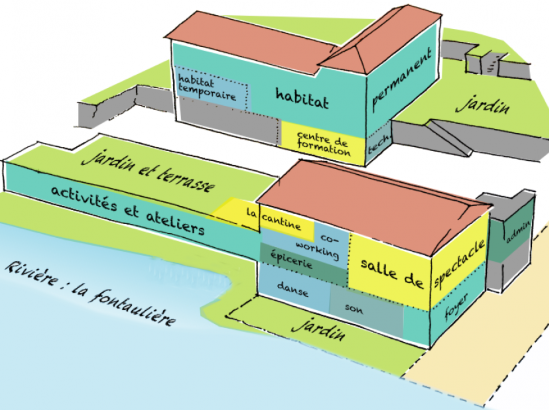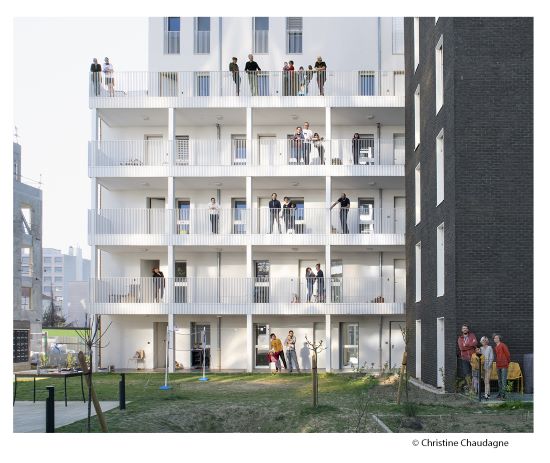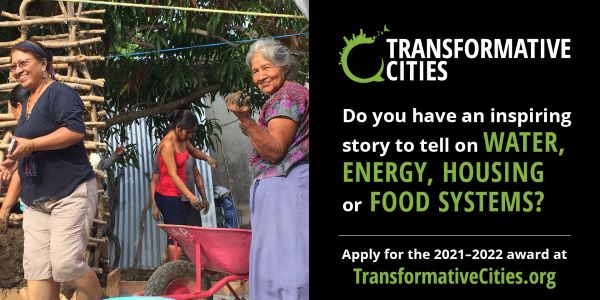Photo Christine Chaudagne – le Cairn – Coopérative d’habitants à Lyon (4th
Long practiced by young people, be them students or not, for economic reasons, colocation has evolved towards other segments of the population throughout the French territory. Shared, grouped, cooperative, inclusive, participatory co-housing is a phenomenon that appeared in the 80s and that challenges our individualistic lifestyles and makes it possible to break the isolation accentuated by modernity.
Shared housing is defined as the desire of several households to pool their resources in order to design and/or finance collective housing. It is a concept based on solidarity, respect for the environment, sharing and social diversity.
Combining the need for privacy and the need for social ties, the collective housing project appears as a solution with multiple advantages. It is not only about the construction of a habitat but also that of a collective. A group is created and decides to live together. Everything has to be decided; What means should be put in place to communicate? How will decisions be made? How do we manage and share tasks?. In the same place come together private spaces and common areas: guest rooms, shared laundry rooms, shared garden and terrace, games room or library. The inhabitants therefore experience group life while respecting everyone’s need for privacy. Objectives of bioconstruction, thermal insulation, energy and water management can be coupled with values of responsible consumption, purchases of local products such as CSA products or in local shops.
Participatory housing is recognized by the French Alur law as “a citizen approach that allows natural persons to join forces in order to participate in the definition and design of their housing and spaces intended for common use, to build or acquire one or more buildings intended for their home and to ensure their subsequent management”.
Beyond living together, the issue is also a political issue, that of the values of solidarity and questioning of private property and non-speculation of real estate, but also self-management, respect for the environment, etc. Residents’ cooperatives or Brussels Community Land Trusts are examples of this. Another vision of urbanization, community, a form of emancipation through its housing tool?
If this phenomenon affects different kinds of populations, it should also be noted that colocation also represents a solution for older populations as demonstrated in the Bastamag article (in French) that presents the first cooperative of inhabitants for aging people in France: Chamarel-les-Barges, in the suburbs of Lyon, created in 2019. In the Bordeaux metropolis, in order not to be alone and to pool livelihoods, retirees create a tailor-made retirement home in cohabitation with collective and private living spaces, as part of a real estate project that is not speculative: the cooperative of inhabitants of Boboyaka la Castagne is under construction.
The self-managed, participatory, ecological and feminist house for women aged 60 and over: the Maison des Babayagas, inaugurated in 2013 in Montreuil after more than 15 years of gestation, is one of the emblematic places of shared housing in France. Of the twenty-five dwellings, twenty-one are reserved for women over 60 years of age, meeting the criteria for access to social housing. The other four, to young people under 30 years of age. Collective vegetable garden, shared monthly meals, associative activities in the neighborhood dot the collective life.
In addition, inclusive housing is a place of life, freely chosen, allowing people in a situation of fragility (related to age, a disability, an illness, etc) to live independently, while benefiting from shared services (health services, meals, animation, socialization time). Article 45 of the French Elan law (23 November 2018) now authorises the colocation of people with disabilities with a maximum of 5 people. One of the benefits of living in a shared habitat is conviviality and socialization within the home, in addition to household help, rehabilitation services, etc.
Even if these forms of housing tend to multiply, the legal (forms), financial, etc. difficulties are still too numerous. The public authorities are not yet sufficiently at the rendezvous. But between utopias and simply practical reasons, the idea of pooling for more autonomy at any age is gaining ground.
Two examples:
Presented by Christiane Châteauvieux for the Habicoop Federation
The inhabitants’ cooperative is a way of living based on the values of solidarity, democracy and responsibility. Housing, like land, is considered as a common that the inhabitants take care of over time, with the idea of transmitting affordable housing to future generations.
The Fédération française des coopératives d’habitants Habicoop supports this model of sustainable collective ownership, for its social utility and for its non-speculative nature. Habicoop represents cooperatives before the public authorities and collaborates with groups or institutions likely to promote the creation of cooperatives. Between 2020 and today, cooperative projects have more than doubled: from 30 to 65! Certainly because housing is becoming affordable economically and these initiatives create social relationships that make them desirable!
More information:
Presented by Laure Carbonnel, resident of the mulinage de Chirols
Le moulinage de Chirols A place of social, artistic, cultural and ecological experimentation
 The moulinage de Chirols is a collective gathered in cooperative and association to make an old factory a place mixing housing (main and temporary residence), activity (workshops), and shared common spaces (participatory canteen, shared offices, theater, etc.)
The moulinage de Chirols is a collective gathered in cooperative and association to make an old factory a place mixing housing (main and temporary residence), activity (workshops), and shared common spaces (participatory canteen, shared offices, theater, etc.)
The collective shares the values of solidarity, non-speculation, and ecology. Each person brings his vision, his needs, to experiment with ways to coexist on the territory. This shared adventure questions another relationship to money and work.
Life at the moulinage is partly devoted to the ecological self-rehabilitation of the place that makes us work together and draw perspectives nourished by very different experiences. Each resident or person with a project works at the same time on his own activity. It is still a multitude of festive and cultural events that set us in motion.
Come and meet us every Friday at 6 p.m. from May to September. To stay informed about the construction sites, the project follow us: https://lemoulinagedechirols.org/, Facebook, Youtube, or participate in the donation campaign on Hello asso .














